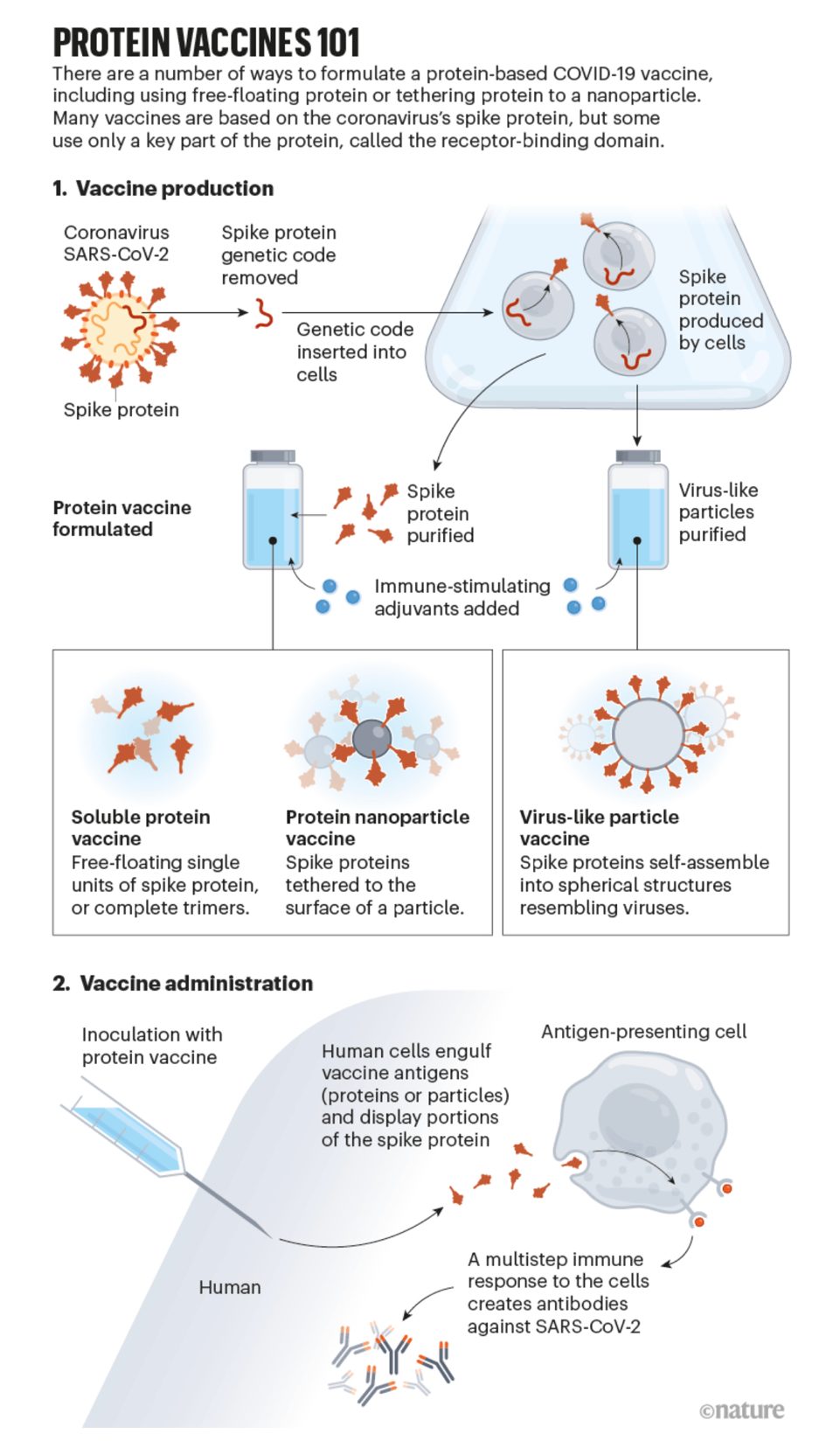If you ever wanted to be vaccinated but had been holding back from getting the jab for fear of blood clotting or other medical complications, rejoice, your troubles will soon be over.
Protein-based vaccines, which are the safest of all the vaccines in the market so far, are about to be introduced in the fight against COVID-19. In fact as I write this article, Friday 17 December 2021, the news has just broken that NVX-CoV2373 COVID-19 Vaccine, marketed under the name Covovax, a protein subunit vaccine produced by Novovax has been granted “Emergency use listing” by the World Health Organisation!
Vaccines teach your body how to recognise an invader (virus) and train it to defend itself against that particular invader. The coronavirus SARS-CoV-2 pandemic has rejuvenated vaccinology. The world’s fear of the devastating effects of COVID-19 has given rise to many vaccines for use to assist the body defend itself and/ or destroy the invading virus:
Join our WhatsApp ChannelThe attenuated (or weakened) whole virus (e.g. the Chinese Sinovac vaccine) has two versions: a live attenuated viral vaccine, which uses a weakened virus. In this case the virus still have the ability to grow and multiply but it does not cause any disease…. except in rare occasions when it reverts to its pathogenic form! But an inactivated version contains a virus with its genetic code destroyed by chemicals, heat or radiation. This means that it cannot grow or multiply but can still induce an immune response. Attenuated vaccines do trigger powerful immune responses, and because of this, they are very effective vaccines.
The nucleic acid-based or mRNA vaccines (e.g. Pfizer-BioNTec, and Oxford-AstraZeneca vaccines) use pieces of the viral genetic material to stimulate immune responses. The piece of genetic material chosen contains instructions, which is read by the host cells. The latter then makes the specific viral protein (or antigen) that will trigger an immune response.
The COVID-19 mRNA vaccines do not require expensive purifications of proteins nor the need to inactivate the virus. They simply deliver the genetic code of the viral antigen, thus making them the fastest vaccines to be produced. They are good for immunocompromised individuals and there is no risk of the viral genetic material integrating with the human host DNA. This is because for a virus like the coronavirus SARS-CoV-2, which is an RNA virus, to insert its RNA genome into the human DNA genome, the RNA needs to be converted first into DNA. To do this, an enzyme called “reverse transcriptase” is required. BUT humans do not have this enzyme. Coronavirus SARS-CoV-2 is a single stranded ribonucleic acid (ssRNA) virus and does not encode a reverse transcriptase either. Therefore the virus cannot convert its RNA into DNA and neither can its mRNA be inserted into a human genome! It is akin to putting a square pole in a round hole OR a Mandarin-speaking diplomat holding a conversation with his/her English-speaking counterpart without the benefit of an interpreter – it will never work because they will not understand each other. Moreover, mRNA COVID-19 vaccines contain only a small piece of the viral genetic material that encodes the spike protein of the virus, and not the full genome!
However, it must be mentioned that a study published in the Proceedings of the National Academy of Sciences (https://www.pnas.org/content/118/21/e2105968118) claimed that it was possible for coronavirus SARS-CoV-2 to invade and integrate into the human genome. But this claim was quickly debunked in at least two papers published in the Journal of Virology (https://doi:10.1128/JVI.00294-21) and in the preprint server for Biology, BioRXiv (https://doi.org/10.1101/2021.03.05.434119), respectively. The main experimental event upon which the claim was made (host-virus chimeric RNA event or the generation of hybrid human-viral sequences) was not reproducible. The claim was disproved as “artifactual” of the methodology employed in the work. In other words, either the researchers obtained the result they were looking for based on an experimental error and/or they applied the wrong interpretation to the result they obtained!
The irrefutable fact, which further faults the claim is that:
“SARS-CoV-2 is a positive-sense RNA virus that replicates in the cytoplasm [of infected host cells], it does not have a nuclear phase in its life cycle. Thus, it is biologically unlikely to be in a location where splicing events could result in genome integration.” _Yan et al., 2021.
Yet we have another class of vaccines based on antibody technology. These vaccines are called monoclonal antibodies, and are designed to generate antibodies that bind to the surface of the virus and block entry into cells. By this mechanism, the virus is neutralised, hence monoclonal antibodies are also known as neutralising antibodies.
Monoclonal antibody is especially adapted for use by people whose immune systems are weak and/ or they have low immune responses after vaccination e.g. the elderly persons. Monoclonal antibody is also used to offer immediate protection for the unvaccinated people who are exposed to the virus, SARS-CoV-19.
The drawback to monoclonal antibodies is that they need to be delivered intravenously in the form of infusions into or under the skin. Also the immune responses generated by monoclonal antibodies lasts for a short period of time therefore, repeated infusions are required to maintain good level of immune responses to the virus.
Subunit, or acellular vaccines contain just pieces of the pathogens that stimulate immune responses. Subunit vaccines are much safer than other vaccines because the fragments of the pathogen used in the production of the vaccines are incapable of causing any disease. It is especially suited for individuals with acute immune responses and also those with compromised immune systems e.g those who have blood clotting conditions.
Subunit vaccines are of 3 types:
A). The protein subunit vaccines contain specially selected viral or bacterial proteins (e.g. hepatitis B and acellular pertussis vaccines).
B). The conjugate subunit vaccines, which rely on binding polysaccharide chains (i.e. chains of sugar molecules) to carrier proteins for stimulation of immune responses (e.g. the MenACWY vaccine against meningitis and septicaemia).
C). The polysaccharide vaccines, which contain bacterial cell wall polysaccharides (e.g. the pneumococcal polysaccharide vaccine).
The immunogenic protein components of the virus are antigens expressed (or manufactured) in eukaryotic expression systems (e.g. yeast, mammalian or insect cells). Eukaryotic expression systems are chosen because we are eukaryotes, therefore, it is necessary for the protein products to undergo post-translational modifications (or refinement) to suit our body requirements.
As in most vaccine designs, protein subunit vaccines for SARS-CoV-2 are centred around the spike protein (or S protein) of the virus. The virus uses this spike protein to gain entrance into cells. Each manufacturer of the protein-based vaccines use a different design technique depending upon convenience (i.e. expertise, cost, etc.). The design technique could be the use of the whole spike protein or a piece of it. Some like GSK-Sanofi and Novavax prefer to express their protein in a moth called fall armyworm (Spodoptera frugiperda), while others like Clover prefer hamster ovary cells.
Protein subunit vaccines in their own generate weak immune responses, hence an adjuvant (e.g. alum, which enhance the body immune response) is co-administered with the vaccines. Nevertheless, they are cheaply produced compared to other vaccine types, and they are very stable at a broad range of temperatures, which is a plus especially in areas where very low temperature refrigeration is problematic.

Given the cheap production process of protein-based vaccines coupled with their temperature broad range stability, they are expected to plug the gap in vaccine shortages seen in most developing and poorer countries.
The Novavax protein subunit vaccine called NVX-CoV2373 COVID-19 Vaccine, has undergone the preliminary safety and immunogenicity clinical trials in Phases 1 and 2. In the final Phase 3 trial to evaluate the vaccine efficacy, safety and immunogenicity, 30,000 volunteers from all over the world were recruited. The vaccine scored more than 90% protection against symptomatic COVID-19 in the trial with an enviable safety profile rivalling, if not better than, Pfizer-BioNTec and Moderna mRNA vaccines.
Based upon this result, Novavax has filed for emergency use listing in many countries, including the EU, Japan, United Arab Emirates and Singapore. Licensing for its NVX-CoV2373 COVID-19 Vaccine, marketed under the name Covovax, has also been applied in Australia, Canada, Indonesia, New Zealand, and the U.K. Surprisingly, the company has not applied to the US Food and Drug Administration (FDA) for emergency use authorisation of its vaccine in the USA. The company has not given any reason for this unusual “oversight”.
Nevertheless, the World Health Organisation has just granted emergency use listing for Covovax and other countries are expected to soon follow suit. This means that deliveries of the vaccine to low and medium-income countries of the world through the global vaccine access scheme, COVAX, would soon be made possible. Already Novovax has signed to supply COVAX with 1.1 billion doses of the vaccine.
There are about 50 protein subunit vaccines against SARS-CoV-2 in various stages of clinical trials from companies around the world besides Novavax, including GSK in collaboration with Sanofi, Clover Biopharmaceutical, SK Bioscience, etc. When these protein-based vaccines hit the markets, their effects will bring into fruition the dream of a world where vaccine supplies outstrip vaccine demands; thus, helping to creating a world safer from COVID-19.
NB: The figure of protein vaccine production presented above was produced by Nik Spencer/Nature, 2021.
P/S: I think we have had enough of science lessons for this year. And in keeping with the spirit of the Christmas season, in the next edition (check under Opinion or Entertainment section), we shall take a lighthearted look at some of the events in the Bible – of course it all depends if my “brave” editor does not flip his lid and chicken out! 😂😂😂
Merry Christmas to you all, see you next year.













